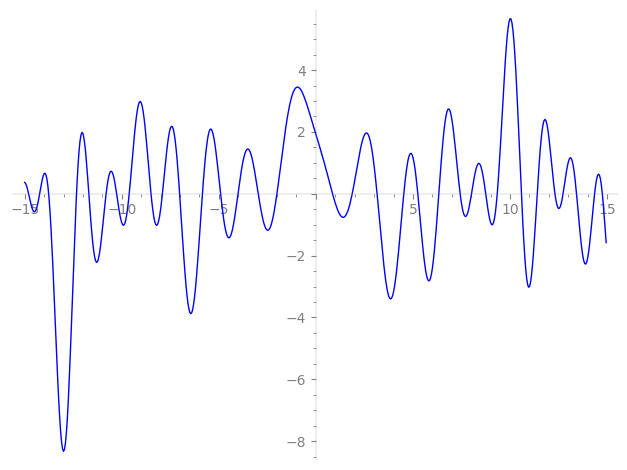| L(s) = 1 | + (0.840 + 1.51i)3-s + 2.34i·5-s + (2.61 + 0.373i)7-s + (−1.58 + 2.54i)9-s + 0.442i·11-s + (−1.96 + 1.13i)13-s + (−3.55 + 1.97i)15-s + (4.01 − 2.32i)17-s + (−3.30 + 5.73i)19-s + (1.63 + 4.28i)21-s − 1.13i·23-s − 0.514·25-s + (−5.18 − 0.267i)27-s + (4.37 − 7.58i)29-s + (−2.32 + 4.01i)31-s + ⋯ |
| L(s) = 1 | + (0.485 + 0.874i)3-s + 1.05i·5-s + (0.989 + 0.141i)7-s + (−0.529 + 0.848i)9-s + 0.133i·11-s + (−0.543 + 0.314i)13-s + (−0.918 + 0.509i)15-s + (0.974 − 0.562i)17-s + (−0.759 + 1.31i)19-s + (0.356 + 0.934i)21-s − 0.236i·23-s − 0.102·25-s + (−0.998 − 0.0515i)27-s + (0.812 − 1.40i)29-s + (−0.416 + 0.721i)31-s + ⋯ |
\[\begin{aligned}\Lambda(s)=\mathstrut & 1008 ^{s/2} \, \Gamma_{\C}(s) \, L(s)\cr =\mathstrut & (-0.539 - 0.842i)\, \overline{\Lambda}(2-s) \end{aligned}\]
\[\begin{aligned}\Lambda(s)=\mathstrut & 1008 ^{s/2} \, \Gamma_{\C}(s+1/2) \, L(s)\cr =\mathstrut & (-0.539 - 0.842i)\, \overline{\Lambda}(1-s) \end{aligned}\]
Particular Values
| \(L(1)\) |
\(\approx\) |
\(1.920895874\) |
| \(L(\frac12)\) |
\(\approx\) |
\(1.920895874\) |
| \(L(\frac{3}{2})\) |
|
not available |
| \(L(1)\) |
|
not available |
\(L(s) = \displaystyle \prod_{p} F_p(p^{-s})^{-1} \)
| $p$ | $F_p(T)$ |
|---|
| bad | 2 | \( 1 \) |
| 3 | \( 1 + (-0.840 - 1.51i)T \) |
| 7 | \( 1 + (-2.61 - 0.373i)T \) |
| good | 5 | \( 1 - 2.34iT - 5T^{2} \) |
| 11 | \( 1 - 0.442iT - 11T^{2} \) |
| 13 | \( 1 + (1.96 - 1.13i)T + (6.5 - 11.2i)T^{2} \) |
| 17 | \( 1 + (-4.01 + 2.32i)T + (8.5 - 14.7i)T^{2} \) |
| 19 | \( 1 + (3.30 - 5.73i)T + (-9.5 - 16.4i)T^{2} \) |
| 23 | \( 1 + 1.13iT - 23T^{2} \) |
| 29 | \( 1 + (-4.37 + 7.58i)T + (-14.5 - 25.1i)T^{2} \) |
| 31 | \( 1 + (2.32 - 4.01i)T + (-15.5 - 26.8i)T^{2} \) |
| 37 | \( 1 + (1.41 - 2.44i)T + (-18.5 - 32.0i)T^{2} \) |
| 41 | \( 1 + (-4.55 + 2.62i)T + (20.5 - 35.5i)T^{2} \) |
| 43 | \( 1 + (3.81 + 2.20i)T + (21.5 + 37.2i)T^{2} \) |
| 47 | \( 1 + (2.67 + 4.63i)T + (-23.5 + 40.7i)T^{2} \) |
| 53 | \( 1 + (1.54 + 2.67i)T + (-26.5 + 45.8i)T^{2} \) |
| 59 | \( 1 + (0.689 - 1.19i)T + (-29.5 - 51.0i)T^{2} \) |
| 61 | \( 1 + (8.88 - 5.13i)T + (30.5 - 52.8i)T^{2} \) |
| 67 | \( 1 + (-2.10 - 1.21i)T + (33.5 + 58.0i)T^{2} \) |
| 71 | \( 1 - 7.20iT - 71T^{2} \) |
| 73 | \( 1 + (-3.17 + 1.83i)T + (36.5 - 63.2i)T^{2} \) |
| 79 | \( 1 + (-7.26 + 4.19i)T + (39.5 - 68.4i)T^{2} \) |
| 83 | \( 1 + (7.87 - 13.6i)T + (-41.5 - 71.8i)T^{2} \) |
| 89 | \( 1 + (-5.32 - 3.07i)T + (44.5 + 77.0i)T^{2} \) |
| 97 | \( 1 + (-14.9 - 8.63i)T + (48.5 + 84.0i)T^{2} \) |
| show more | |
| show less | |
\(L(s) = \displaystyle\prod_p \ \prod_{j=1}^{2} (1 - \alpha_{j,p}\, p^{-s})^{-1}\)
Imaginary part of the first few zeros on the critical line
−10.26482060265230880774690007999, −9.615620031152461354943804477765, −8.493133870226677635929990563177, −7.905879943679697124542325822206, −7.01933283097486883172921652261, −5.84588792245026642328206651753, −4.91000890442890078047368194383, −4.01151164497447863732028963719, −2.96967904113476592325491842528, −2.00699989782905030023107826272,
0.856887634041106552212204012146, 1.87109750159843865833544747191, 3.15067882167686014764604458363, 4.52737822673152156949310466722, 5.24957884952684272222528940887, 6.33159900830591290745743962870, 7.42980299495439877718824724409, 8.015881922716764302385312502744, 8.747040027341838490365993310078, 9.340011702950142830336197411289

